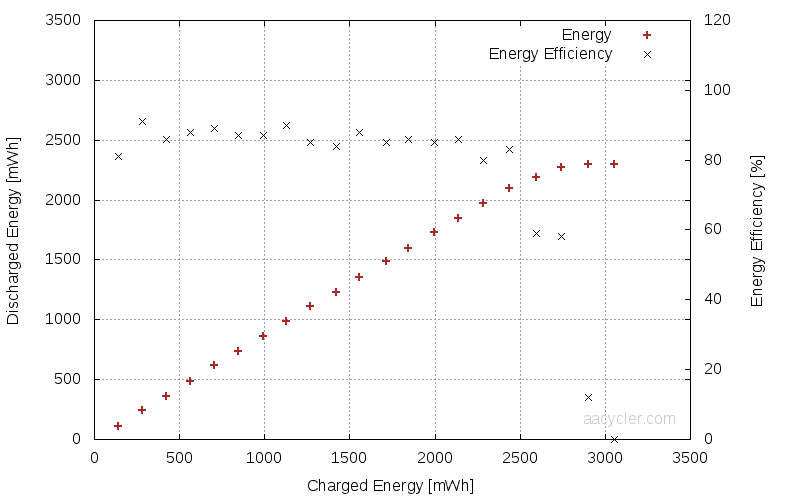NiMH Charge and Energy Efficiency
Inspired by HKJ’s NiMH Battery Charging article and after doing some research on internet I learned that
- NiMH cells have 100% charge (faraday, coulombic) efficiency up to 90% SoC
- NiMH cells have the highest energy efficiency around 50% SoC and for energy-efficient applications (hybrid cars) are best used between 40%-60% SoC
I also learned that there are two chemical reactions happening during charging. The primary charge reaction is desirable, but from approx 80% SoC a parasitic side-reaction starts competing with the primary reaction and becomes dominant in the overcharge region. This parasitic reaction is responsible for oxygen evolution, nickel electrode swelling, warms up the cell and increases its pressure. In overcharge state it causes a slight voltage drop. The effect of this parasitic reaction is mostly reversible by discharging the cell.
But enough of theory, let’s do some tests…
Test Method
The test is performed on SkyRC MC3000 for its accuracy and Panasonic Eneloop for its consistency. Both charge and discharge currents are 1.5 A.
- initialize the cell with two charge-discharge cycles, leave the cell discharged (our 0% SoC)
- charge a certain amount of capacity (start with 100mAh) into the cell, note down how much charge and energy went into the cell
- discharge the cell to 0% SoC, measure how much charge and energy was extracted from the cell
- calculate the increments, graph the results
- keep increasing the charge capacity in 100mAh increments and keep repeating Steps 2-4 until feasable
Charge Efficiency

Energy Efficiency

Conclusion
- NiMH cells have 100% charge efficiency up to 90% SoC - confirmed
- NiMH cells have the highest energy efficiency around 50% SoC - confirmed. Eneloops have energy efficiency across wider range of 20%-80% SoC, not just 40%-60%
General Notes
- -dV is a symptom of parasitic reaction happening in cell and is far beyond the 100% charge efficiency point
- 0dV is only slightly better than -dV, it exposes the cell to shorter damage. It is probably the best compromise between capacity and lifespan.
Eneloop Notes
- 100% charge efficiency ends somewhere between 1700 and 1800 mAh
- overall energy efficiency is around 86%
- -dV - IN: 1974 mAh, 2856 mWh, OUT: 1864 mAh, 2292 mWh
- 0dV - IN: 1940 mAh, 2807 mWh, OUT: 1859 mAh, 2283 mWh
- 1.48V - IN: 1699 mAh, 2442 mWh, OUT: 1704 mAh, 2094 mWh
Cheers,
AA Cycler